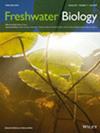Submerged Macrophyte Coverage and Composition: Key Regulators of Buffering Capacity and Resilience in Freshwater Ecosystems to Nutrient Pulses
IF 2.7
2区 生物学
Q2 ECOLOGY
引用次数: 0
Abstract
- Climate change is driving more frequent extreme rainfall events, which in turn trigger nutrient pulse events. These events can degrade water quality and reduce biodiversity in receiving water bodies. While submerged macrophytes are critical for stabilising aquatic ecosystems during such nutrient pulses, differences in macrophyte composition and coverage may affect their functional effectiveness.
- This study simulated nutrient pulse events by conducting in situ mesocosm experiments to investigate the effects of different macrophytes composition (single-species community [Vallisneria natans] vs. multi-species community [V. natans + Hydrilla verticillata + Potamogeton wrightii]) and coverage levels (0%, 30%, 40%, 50% and 60%) on system buffering capacity and stability. Additionally, we identified the coverage thresholds required for stabilising aquatic ecosystems under pulse loading conditions.
- Higher submerged macrophyte coverage significantly reduced TN, TP, Chl-a concentrations and water turbidity, with a critical threshold of 50% macrophyte coverage for optimal nutrient pulse mitigation. Compared with mixed communities, monocultures of V. natans showed better nutrient buffering capacity, with TN and TP removal efficiencies increased by 1.93 and 1.49 times at 50% coverage.
- Selecting appropriate submerged macrophyte coverage and suitable community compositions is crucial for improving ecological restoration efforts, especially in reducing nutrient disturbances and maintaining long-term aquatic ecosystem stability.
淹没植物盖度和组成:淡水生态系统对养分脉冲缓冲能力和恢复力的关键调节因子
气候变化导致极端降雨事件更加频繁,进而引发养分脉冲事件。这些事件会降低水质,减少接收水体的生物多样性。虽然在这种营养脉冲期间,水下大型植物对稳定水生生态系统至关重要,但大型植物组成和覆盖范围的差异可能会影响它们的功能有效性。本研究通过原位中生态实验模拟养分脉冲事件,研究不同大型植物组成(单物种群落[缬草]和多物种群落[缬草])的影响。水蛭+水蛭+白芋])和覆盖水平(0%、30%、40%、50%和60%)对系统缓冲能力和稳定性的影响。此外,我们确定了在脉冲加载条件下稳定水生生态系统所需的覆盖阈值。较高的淹没植物覆盖度可显著降低全氮、总磷、Chl-a浓度和水浑浊度,而50%的淹没植物覆盖度是缓解养分脉冲的最佳临界阈值。与混合群落相比,单作水草具有更好的养分缓冲能力,50%盖度下,水草对全氮和总磷的去除效率分别提高了1.93倍和1.49倍。选择合适的淹没植物盖度和群落组成对于改善生态恢复工作,特别是减少营养干扰和维持水生生态系统的长期稳定至关重要。
本文章由计算机程序翻译,如有差异,请以英文原文为准。
求助全文
约1分钟内获得全文
求助全文
来源期刊

Freshwater Biology
生物-海洋与淡水生物学
CiteScore
5.90
自引率
3.70%
发文量
162
审稿时长
2 months
期刊介绍:
Freshwater Biology publishes papers on all aspects of the ecology of inland waters, including rivers and lakes, ground waters, flood plains and other freshwater wetlands. We include studies of micro-organisms, algae, macrophytes, invertebrates, fish and other vertebrates, as well as those concerning whole systems and related physical and chemical aspects of the environment, provided that they have clear biological relevance.
Studies may focus at any level in the ecological hierarchy from physiological ecology and animal behaviour, through population dynamics and evolutionary genetics, to community interactions, biogeography and ecosystem functioning. They may also be at any scale: from microhabitat to landscape, and continental to global. Preference is given to research, whether meta-analytical, experimental, theoretical or descriptive, highlighting causal (ecological) mechanisms from which clearly stated hypotheses are derived. Manuscripts with an experimental or conceptual flavour are particularly welcome, as are those or which integrate laboratory and field work, and studies from less well researched areas of the world. Priority is given to submissions that are likely to interest a wide range of readers.
We encourage submission of papers well grounded in ecological theory that deal with issues related to the conservation and management of inland waters. Papers interpreting fundamental research in a way that makes clear its applied, strategic or socio-economic relevance are also welcome.
Review articles (FRESHWATER BIOLOGY REVIEWS) and discussion papers (OPINION) are also invited: these enable authors to publish high-quality material outside the constraints of standard research papers.
 求助内容:
求助内容: 应助结果提醒方式:
应助结果提醒方式:


